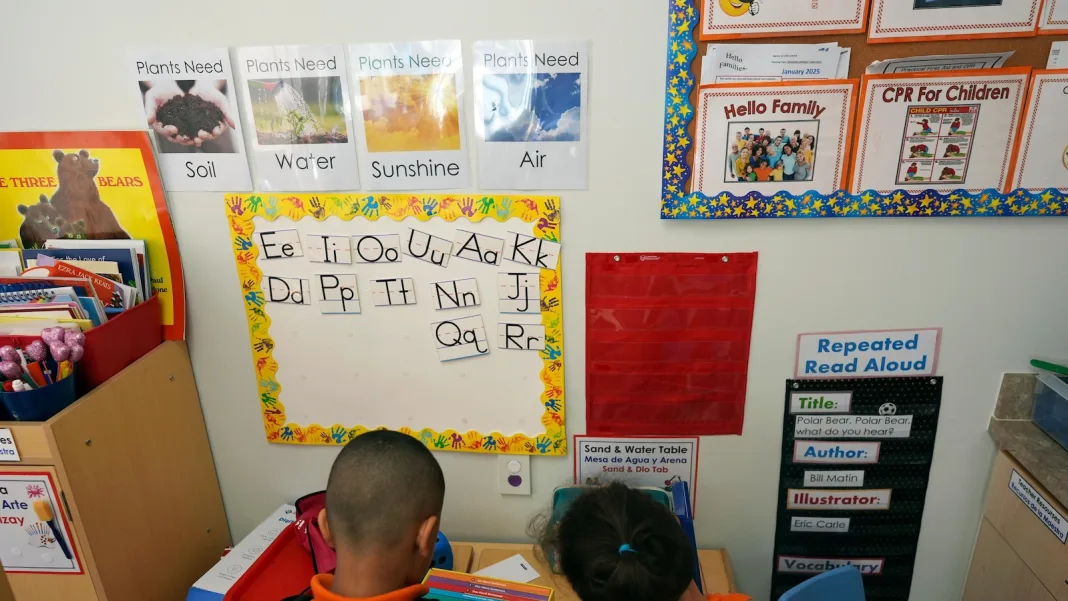The government shutdown is triggering a wave of closures of Head Start centers, leaving working parents scrambling for child care and shutting some of the nation’s neediest children out of preschool.
Dozens of centers are missing out on federal grant payments that were due to arrive Nov. 1. Some say they’ll close indefinitely, while others are staying afloat with emergency funding from local governments and school districts. The closures mean Head Start students — who come from low-income households, are homeless or are in foster care — are missing out on preschool, where they are fed two meals a day and receive therapy vital to their development.
“Children love school, and the fact that they can’t go is breaking their hearts,” said Sarah Sloan, who oversees small-town Head Start centers in Scioto County, Ohio. Staff told families they planned to close Monday. “It’s hampering our families’ ability to put food on the table and to know that their children are safe during the day.”
A half-dozen Head Start programs never received grants that were anticipated in October, but there are now 140 programs that have not received their annual infusion of federal funding. All told, the programs have capacity to assist 65,000 preschoolers and expectant parents.
Among the preschools closing as of Monday are 24 Migrant and Seasonal Head Start centers spread across five states. Those centers, created to assist the children of migrant farmworkers, typically operate on 10- to 12-hour days to accommodate the long hours parents work on farms.
Children attending the centers in Florida, Georgia, North Carolina, Alabama and Oklahoma recently came home with fliers warning of possible closures, along with other parent notifications. Those centers serving more than 1,100 children will now remain closed until the shutdown ends, said East Coast Migrant Head Start Project CEO Javier Gonzalez. About 900 staff members across the centers also have been furloughed.
In the absence of other options for child care, some parents’ only option may be to bring their young child to the fields where they work, Gonzalez said.
Many of the families that qualify for the federal preschool program also depend on food aid through the Supplemental Nutrition Assistance Program, better known as SNAP or food stamps. That program also was on track to run dry of money due to the shutdown, although a pair of federal judges on Friday ordered the Trump administration to keep the program running with emergency reserve funds.
That means many Head Start families have been worried about food aid, along with the child care they rely on to make ends meet. A day without child care means a day without work for many parents — and a day without pay.
In Kansas City, Missouri, Jhanee Hunt teaches toddlers at a Head Start site, the Emmanuel Family and Child Development Center, where her 6-month-old son is cared for in another classroom. The center said it can scrape up enough money to stay open for a few weeks, but the money won’t last much beyond November.
At dropoff, she said, parents often are wearing uniforms for fast food restaurants like Wendy’s and McDonald’s. Some work as certified nurse assistants in nursing homes. None have much extra money. The most urgent concern right now is food, she said.
“A lot of the parents, they’re, you know, going around trying to find food pantries,” she said. “A parent actually asked me, do I know a food pantry?”
More than 90% of the center’s families rely on SNAP food assistance, said Deborah Mann, the center’s executive director. One construction company offered to help fill the grocery carts of some families that use the center. But overall, families are distressed, she said.
“We’ve had parents crying. We’ve had parents just don’t know what to do,” Mann said.
Launched six decades ago as part of President Lyndon B. Johnson’s War on Poverty, Head Start programs provide a range of services beyond early education, such as medical and dental screenings, school meals and family support to children from low-income households who can’t afford other child care options.
The initiative is funded almost entirely by the federal government, leaving it with little cushion from funding disruptions.
Some that have missed out on grant payments have managed to remain open, with philanthropies, school districts and local governments filling in gaps. Others are relying on fast-dwindling reserves and warn they can’t keep their doors open for much longer.
“If the government doesn’t open back up, we will be providing less services each week,” said Rekah Strong, who heads a social services nonprofit that runs Head Start centers in southern Washington state. She’s already had to close one center and several classrooms and cut back home-based visiting services. “It feels more bleak every day.”
In Florida, Head Start centers in Tallahassee and surrounding Leon County closed Oct. 27, but then reopened the next day thanks to a grant from Children’s Services Council of Leon County. The local school district and churches have stepped up to provide meals for the children.
“It takes a village to raise a child, and our village has come together,” said Nina Self, interim CEO of Capital Area Community Action Agency.
But children in rural Jefferson and Franklin counties, where the agency runs two small Head Start centers, were not as lucky. They’ve been closed since late October.
___
The Associated Press’ education coverage receives financial support from multiple private foundations. AP is solely responsible for all content. Find AP’s standards for working with philanthropies, a list of supporters and funded coverage areas at AP.org.






